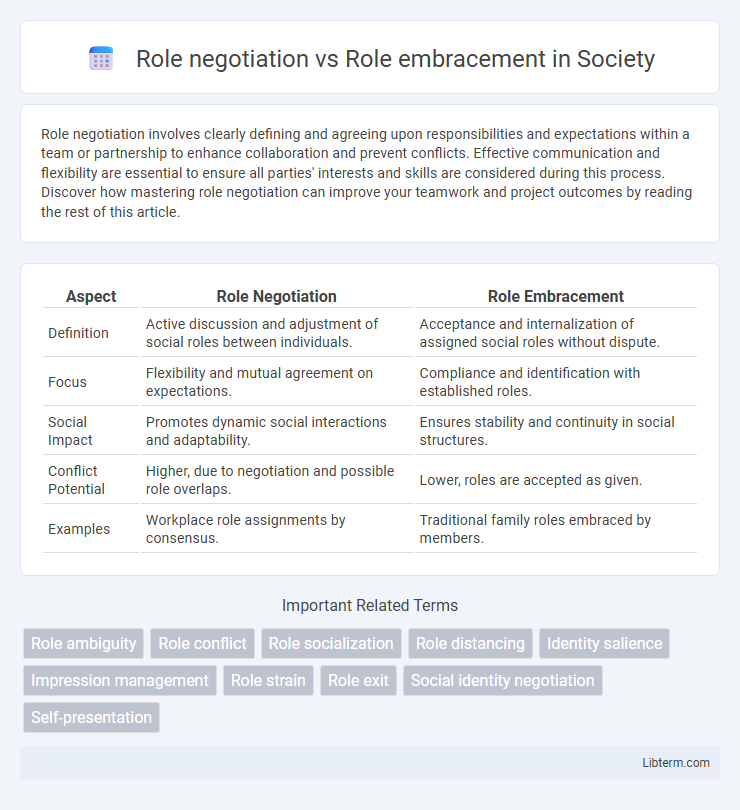Role negotiation involves clearly defining and agreeing upon responsibilities and expectations within a team or partnership to enhance collaboration and prevent conflicts. Effective communication and flexibility are essential to ensure all parties' interests and skills are considered during this process. Discover how mastering role negotiation can improve your teamwork and project outcomes by reading the rest of this article.
Table of Comparison
| Aspect | Role Negotiation | Role Embracement |
|---|---|---|
| Definition | Active discussion and adjustment of social roles between individuals. | Acceptance and internalization of assigned social roles without dispute. |
| Focus | Flexibility and mutual agreement on expectations. | Compliance and identification with established roles. |
| Social Impact | Promotes dynamic social interactions and adaptability. | Ensures stability and continuity in social structures. |
| Conflict Potential | Higher, due to negotiation and possible role overlaps. | Lower, roles are accepted as given. |
| Examples | Workplace role assignments by consensus. | Traditional family roles embraced by members. |
Understanding Role Negotiation
Understanding role negotiation involves actively communicating expectations and responsibilities between team members to align individual and organizational goals. This dynamic process enhances collaboration by clarifying role boundaries and adjusting duties based on mutual agreement and situational demands. Effective role negotiation reduces conflict and increases job satisfaction by fostering transparency and flexibility in role assignments.
Defining Role Embracement
Role embracement involves fully accepting and internalizing assigned responsibilities, aligning personal values and identity with the role's requirements to achieve higher commitment and performance levels. Unlike role negotiation, which centers on discussing and modifying role expectations, role embracement emphasizes psychological ownership and intrinsic motivation in fulfilling duties. Defining role embracement requires understanding its impact on job satisfaction, employee engagement, and overall organizational effectiveness.
Key Differences Between Role Negotiation and Embracement
Role negotiation involves active communication and flexibility to define and adjust responsibilities within a team or organization, prioritizing mutual agreement and collaboration. Role embracement refers to the acceptance and internalization of assigned duties, emphasizing commitment and identification with the role without questioning or altering its boundaries. The key difference lies in negotiation's dynamic and adaptive process versus embracement's static acceptance and dedication to predefined responsibilities.
Factors Influencing Role Choice
Factors influencing role choice between negotiation and embracement include individual personality traits such as assertiveness and adaptability, organizational culture that encourages flexibility or prescribes defined responsibilities, and the clarity of role expectations provided by management. Employees with proactive communication skills tend to engage in role negotiation to align tasks with personal strengths, while those valuing stability and clear guidelines are more likely to embrace assigned roles. External pressures like workload, team dynamics, and leadership support also significantly shape whether individuals negotiate their roles or accept them as given.
Psychological Aspects of Role Adoption
Role negotiation involves active communication and mutual adjustment between individuals to define expectations and boundaries, fostering psychological safety and reducing role conflict. Role embracement reflects an internal acceptance and integration of the assigned role, promoting self-identity coherence and intrinsic motivation. Both processes impact psychological well-being by influencing clarity, autonomy, and role satisfaction within social and organizational contexts.
Impact on Team Dynamics
Role negotiation enhances team dynamics by fostering open communication and mutual understanding, allowing members to align responsibilities with individual strengths and preferences. Role embracement solidifies trust and accountability, as team members fully commit to their defined roles, promoting efficiency and consistent collaboration. Balancing negotiation and embracement minimizes conflict and maximizes productivity, creating a cohesive and adaptive team environment.
Benefits of Role Negotiation in Organizations
Role negotiation promotes clarity and flexibility by enabling employees to discuss and define their responsibilities, which enhances job satisfaction and reduces role conflict. Organizations benefit from increased adaptability as negotiated roles allow for adjustments based on evolving team needs and individual strengths. This proactive communication fosters collaboration, improves performance, and supports a dynamic work environment.
Advantages of Role Embracement for Individuals
Role embracement enhances individual confidence by fostering a strong sense of identity and ownership in assigned tasks. Embracing roles promotes intrinsic motivation, leading to higher job satisfaction and improved performance. This approach also encourages adaptability, enabling individuals to develop specialized skills and contribute more effectively to team objectives.
Challenges in Balancing Negotiation and Embracement
Balancing role negotiation and role embracement presents challenges such as managing conflicting expectations between personal identity and organizational demands. Employees may struggle to assert their needs while fully accepting assigned responsibilities, leading to potential role ambiguity or stress. Effective communication and adaptive strategies are essential to harmonize individual goals with collective objectives in diverse work environments.
Strategies for Effective Role Management
Effective role management involves clearly defining responsibilities in role negotiation to align expectations and reduce conflicts. Role embracement requires individuals to internalize and adapt to their assigned roles, fostering commitment and performance. Strategies such as open communication, continuous feedback, and flexibility enhance both negotiation and embracement, optimizing organizational dynamics.
Role negotiation Infographic

 libterm.com
libterm.com